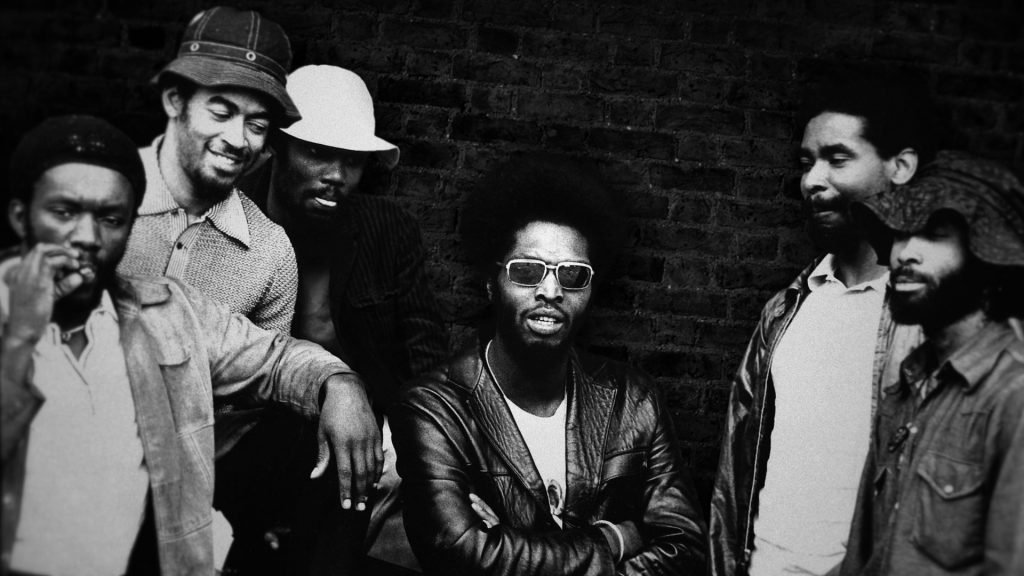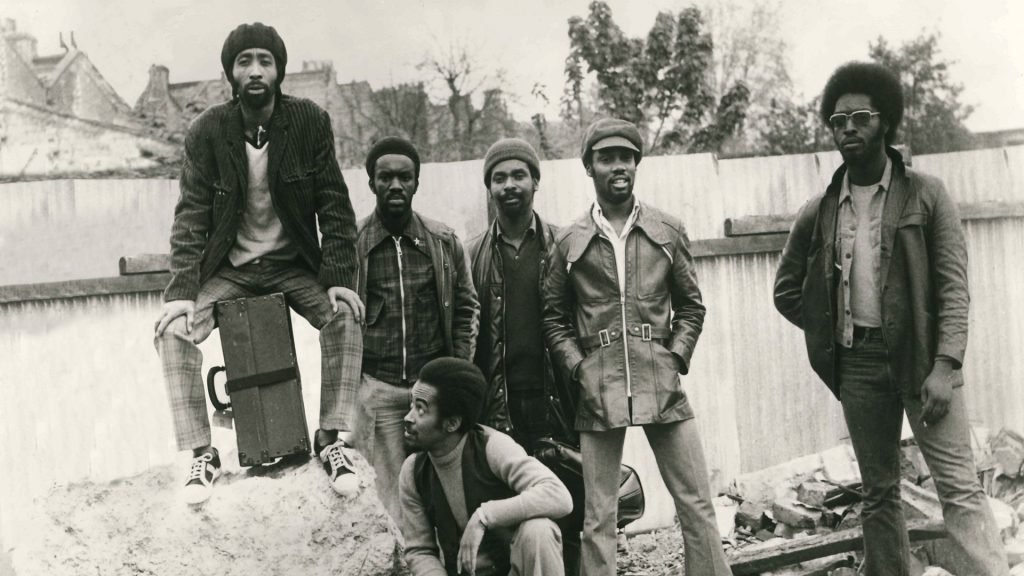You may not have heard of Cymande, but the likelihood is you’ve heard them…
Their work has been sampled in various genres, from hip-hop to house and beyond, their influence goes from the genius of DJ culture and the start of disco. They scored high the US charts, supported Al Green on tour, even packed out the famed Apollo Theatre in Harlem, yet never charted in their home, Great Britain, ultimately splitting in the mid-70s. (Though, as we find out, that was by no means the end of their story.)
Childhood friends and neighbours guitarist Patrick Patterson and bass player Steve Scipio founded the band, soon picking up drummer Sam Kelly, percussionist Pablo Gonsales, saxophonist Derrick Gibbs and flautist/saxophonist Mike ‘Bammi’ Rose. It’s the rhythm section of Scipio’s bass, Patterson’s guitar and Kelly’s drums that draw you in. Often falling into a proto-disco sound, four-to-the-floor beats, the same time as Eddie Kendrick’s Girl You Need A Change Of Mind and Philadelphia International’s Gamble and Huff are evolving the Motown sound to the disco it will soon become. The nearest comparison is the rhythms of the Fatback Band, but what comes over it is something else again.

Director Tim Mackenzie-Smith, better known for sports documentaries, rattles through this early stage at frenetic pace. There’s a sensation that this mix of funk, prog rock and Rastafarian melodies and lyrics fell out of nowhere. To be fair, Pablo doesn’t even remember the recording sessions. Mark Ronson describes it as ‘other worldly’, but the sound is so different it would be nice to get a better handle on how it came about.
Instead, we see them debut on the US label Janus Records almost by chance. For a band with a West Indian background and sound, the reception in the USA shouldn’t be underrated. Their self-titled debut was released in 1972. This is before Bob Marley, who was one of the few acts to break through, but only by being seen as a rock act. In reality, it took America until the 90s to properly understand (and buy) music from the West Indies. Conversely, thanks to the Wind Rush generation, reggae became a mainstay in the UK charts from the late 60s, and in no way bound to just Black audiences.
Within 30 minutes we’ve seen the rise, and then… stop of Cymande. As they finally returned home to find no one knew them or cared to even give them gigs. I mean… they played support for Al Green!
Born of those racial tensions, they played easily part in what happened next. As Craig Charles puts it well, ‘We were never allowed to have our “Golden age of British Soul”.’ It’s sadly true. What could have been a point to build on a scene was cut short, as was the Brit Funk scene of the late 70s and early 80s, and the rare groove/Acid Jazz of the late 80s and early 90s. Nothing ever stuck long enough to build on. When Jazzie B spoke to Blues & Soul Magazine in January 1990, their early singles still making waves both in the UK and US, he quoted them as a well-known salutary lesson. “We thought back to the Seventies, to what happened to groups like Cymande, and we wanted to make sure that whoever we worked with understood the whole artist development thing is essential.” (In hindsight, conditions were a little kinder to Soul II Soul.)
It’s then Mackenzie-Smith turns on the detail. In the mid-70s tracks Bra became part of two very different DJ scenes in New York. On the one side, the burgeoning club scene beginning around disco. Bra lends itself to that early classification, with a bass-only break in the middle, followed by that four-to-the-floor drumbeat, before Kelly shifts back to that shuffling beat, just behind the bassline. Why Kelly isn’t considered one of the most influential drummers of all time is beyond me. (For a casual viewer, that this is the “new music” nightclub founder of The Gallery and former Studio 54 DJ Nicky Siano is talking about is disco will be lost.)

On the other side, into Brooklyn we have the early stirrings of hip hop, using two turntables with the same track and playfully flipping between them. In a sense creating a brand new version of the song. This is the nucleus of the next stage for Cymande, and how most people first came to their songs. Cymande are a crate-digging music nerd’s wet dream. For me, it was the samples and ‘lifted’ baselines. There was Vaughn Mason’s Raze and Jack The Groove in 1986. One of several House records to use the bassline of Bra within 12 months, alongside House People’s Godfather Of House and Cleavage’s Barah, only this one made the UK top 20! Also sampling Bra, there was De La Soul’s Change In Speak on their 3 Feet High And Rising LP, and D Mob’s It Is Time to Get Funky, both from 1989. Aswad covered The Message in 1988, the first song on their big crossover album Distant Thunder, right before their number 1 UK hit Don’t Turn Around. By the time Cymande’s songs started to appear on compilation albums, the threads started coming together.
In the 90s we had Ruthless Rap Assassins And It Wasn’t A Dream, Masta Ace’s Me And The Biz and MC Solaar’s Bouge De La (all sampling The Message), and The Fugee’s The Score from their multiplatinum-selling album of the same name. It seems from the 70s on, each decade has brought a flood of new fans to their work. Like me, everyone has largely the same story. There’s no shortage of vox pops from all sorts of fans. But while some might be cute, like De La Soul’s DJ Maseo getting into the band from his mum’s collection, they can get repetitive. By the time we get to Khruangbin, they may be sharing their love of Cymande, but maybe less all those even more obscure African disco records they’re listening to.
The band didn’t just disappear through. Patterson and Scipio both became solicitors, Kelly and Bummi fell into session work, with Bummi joining the brass section of Aswad throughout the 70s and 80s, playing on the iconic track Warrior Charge. (He also played on their cover of The Message, which oddly isn’t mentioned at all. But if that’s the biggest factual omission from someone who knows a lot about the subject, then I suspect Mackenzie-Smith may be one of the biggest music nerds of all.) In the mid-2010s, long overdue, the band got together again to perform. Beginning a series of concerts that saw them tour the world from 2014 well into 2018. (I remember seeing them at the Barbican Centre in 2015.) When superfans like MC Solaar or DJ Maseo meet them, it’s hard to work out who is more emotional. But that there’s a big gap between the payoff of seeing them ‘get it back’ and now feels like the documentary loses some momentum. Covid aside, it would have made more sense to see this documentary released in 2020 or 2021. Pablo Gonsales died on 2 December 2020, which is caught in a closing caption of the film. A newer recruit to their ranks, Ray Carless – a Brit Funk hero in his own right thanks to his single Tarantula Walk and work with major bands on the scene like Incognito, Light Of The World and more – died on 11 August 2022.
Ultimately, and it sounds like a strange point to make, Getting It Back’s biggest strength is allowing the music to speak for itself. Sometimes that may be an issue with licensing rights. The situation with the recent Sinead O’Connor documentary Nothing Compares is a case in point. Prince’s estate refused point blank to licence the title song, no doubt fuelled by O’Connor’s allegations. With others other indulgences seem at play. Like on Bitchin’: The Sound and Fury of Rick James, which features a soundtrack by the team of Ali Shaheed Muhammad and Adrian Younge. Known for their work on the Luke Cage series and as The Midnight Hour and Jazz Is Dead releases, however talented they are, it just doesn’t fit with James’s aesthetic. Here it seems the band retained the rights to their own music, making that part easier, which may have had more to do with no one being interested. But with bands like De La Soul and later acknowledging them on compositions, it’s meant they’ve always had that money coming in.
The music is so powerful and moving, that if you don’t come out of the film wanting to track down and listen to more Cymande, then there really must be something wrong with you. Surely?
Getting It Back: The Story Of Cymande screens as part of the BFI London Film Festival 2022.
Thanks for the really thoughtful review guys, from one music nerd to another! Btw we asked Bammi about playing on The Message Aswad cover, but he couldn’t remember!
— CYMANDE MOVIE (@CymandeMovie) October 6, 2022